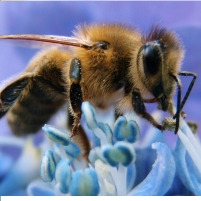Mass Honeybee Deaths Linked to Insecticide
Tuesday, January 31, 2012

Agricultural chemicals may be partly responsible for the massive die-off of honeybees in the U.S., according to researchers at Purdue University. Entomologists have found the presence of neonicotinoid insecticides, which are used on corn and soybean seeds and are known to be “highly toxic to bees; we found them in each sample of dead and dying bees,” Christian Krupke, associate professor of entomology, told Purdue Daily. Except for organically grown crops, almost all corn seeds planted in the United States are coated with neonicotinoid insecticides, leading to exposure to honeybees foraging near corn fields.
Honeybees pollinate about 30% of all food consumed and contribute $15-20 billion a year in agriculture revenue for the U.S. The U.S. is currently losing about one-third of its honeybee hives each year. Some researchers (and pesticide manufacturers, such as Bayer) have maintained that the die-offs have been caused not by pesticides, but by viruses and fungi.
-David Wallechinsky, Noel Brinkerhoff
To Learn More:
Purdue Researchers Greg Hunt and Christian Krupke: Honeybee Deaths Linked to Seed Insecticide Exposure (by Brian Wallheimer, Purdue Today)
Multiple Routes of Pesticide Exposure for Honey Bees Living Near Agricultural Fields (by Christian Krupke, Greg Hunt, Brian Eitzer, Gladys Andino and Krispn Given, PLoS One) (pdf)
What Killed the Honeybees, Fungus or Pesticides? (by Noel Brinkerhoff, AllGov)
- Top Stories
- Unusual News
- Where is the Money Going?
- Controversies
- U.S. and the World
- Appointments and Resignations
- Latest News
- Trump to Stop Deportations If…
- Trump Denounces World Series
- What If China Invaded the United States?
- Donald Trump Has a Mental Health Problem and It Has a Name
- Trump Goes on Renaming Frenzy






Comments